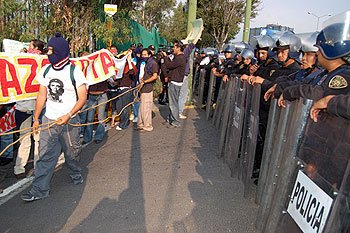


Students Maintain Blockade Despite Repression
Police Beat and Gas Students at the National School of Anthropology and History
By Juan Trujillo
The Other Journalism with the Other Campaign in Mexico City
May 13, 2006
MEXICO CITY, MAY 11, 2006: In keeping with the resolutions taken in the National Assembly of the Other Campaign in San Salvador Atenco, dozens of students from the National Autonomous University of Mexico (UNAM in its Spanish initials) began the blockade of Insurgentes Avenue – the largest city thoroughfare in Latin America – at 8:30 am sharp on May 11. Without any major conflict, the students were able to negotiate directly with the police who approached the demonstration. The agreement: to keep one lane of traffic open to let the vehicles pass in order to inform the drivers and hand out flyers explaining the violence in the last few days that the media have hidden. Surveillance helicopters flew over the entire campus.
 Photos: D.R. 2006 Erwin Slim |
The UNAM students were immediately concerned about the reported use of tear gas and pepper spray at the ENAH.
Moments later, upon arriving at the ENAH facilities, this reporter was able to observe a long line of Mexico City police along the fence that leads to the Cuicuilco archeological site. There in charge of “public order” were some 300 officers, led by the Department of Public Safety’s Task Force Group (AFT).
Rocks, Glubs, Gas and Beatings
Although Mexico City’s secretary of public safety, Joel Ortega, assured that no one was injured or arrested and that the police had gone in unarmed, the students’ version of the events was completely different.
 |
The atmosphere changed to one of tension, fear and distress among the students and professors. Confusion and anger over the direct attack on the campus ruled.
According to another student, an ethnology major who also asked to remain anonymous, “the police were already there before the blockade began. They ran into the Periférico, pushing through with their shields, hitting and launching gas.” The tearing eyes and pale face of this student bore witness to the effect of the repressive action. But the confrontation continued between the two sides: “We started to throw stones from the campus, and they responded. There were about three people injured in the head… We asked for dialog, but the commander who was in charge of the operation preferred to repress first and negotiate later.”
According to this student, there were at least four people injured from the ENAH, two from a local high school and five from CCH South, who were beaten by police. As he showed this reporter the marks left by blows to his chest, he commented that “many people have experienced hostilities in the streets, and have been infiltrated. There are people who try to intimidate us and then slip away.” He remembered how on March 16, during the World Water Forum in Mexico City, the students also protested and “we were also repressed, probably by the same people, civilians.”
The students were obviously trying to carry out a peaceful protest today. The ethnology student was firm and honest in his declaration with respect to the current situation in the country: “It was a confrontation between the ENAH and the police. Our goal was simply to inform, to have some effect on civil society.” As others had claimed, he said that “there was o dialog, before we came out the police was already there, the ENAH surrounded by state forces.”
The Injured
Moments later, as this reporter was in the ENAH buildings documenting the number and names of the injured with the help of Radio Zapote, the several student groups — with solidarity in their eyes and energy in their feet — managed to negotiate with the police chiefs in order to march down Insurgentes Avenue to “University City,” the UNAM campus, where demonstrators where were blocking that artery. The students from the ENAH, CCH South, UPN and members of the metropolitan coordinating committee if the Other Campaign regrouped and walked together to the 1:00 pm meeting at the UNAM administration building.
 |
In the afternoon, ENAH director José Ortiz Pedraza gave a press conference where he played a video taken by one student of the police aggression. Ortiz said that the forces of order, contrary to what had happened at other blockades that day, had no desire to negotiate with the students. He expressed the great concern with which the communities had received news of the violent repression.
The only injured that day were at the ENAH demonstration: Carlos Pérez Garcia (ENAH), Susana López Martinez (CCH South), Daniel A Sánchez Vázquez (CCH South), Emiliano Garcia Moreno (CCH South), Samuel González Contreras (CCH South), Daniel Santa Maria (CCH South) and Edith Asial (ENAH). That night it was reported that there were blockades all around the city — on five highways leading out of the city and several major avenues— but in the end none of them had any more success than the one at UNAM. Especially on the blockades of city streets, the police easily broke up the blockades.
But it was a day of energy and rebellion for the students. This could be the genesis of a real movement coming out of the solidarity of the classroom.
Click here for more Narco News coverage of Mexico
Lea Ud. el Artículo en Español
- The Fund for Authentic Journalism
For more Narco News, click here.




